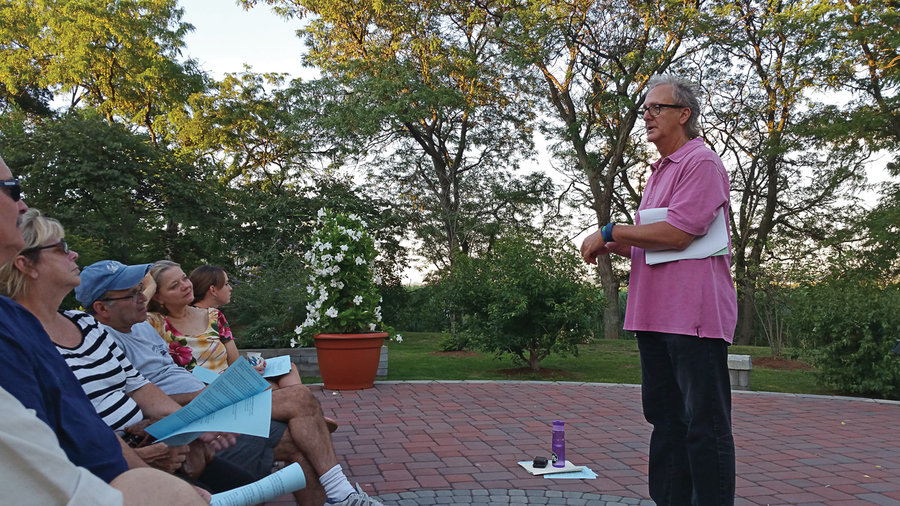The Secaucus Environmental Department has offered a three-week series of speakers during July giving public talks about the local environment. On Wednesday, July 27, the last talk featured Montclair’s Sustainability Officer Gray Russell at the Recreation Center’s meditation garden, discussing how residents can keep their lawns green and plants in bloom using no pesticides and little water.
It starts with healthy soil.
“Farmers and gardeners understand the importance of having manipulative soil that they can dig into, plants can grow in it, and it will reject diseases,” Russell said to the 10 attendees who came. “It’s important to have healthy soil. But how do you know it’s healthy?”
Russell suggested residents conduct a soil test. “It’s easy, takes little time, and is about $20.” According to Russell, anyone can go to Rutgers University or their website to do a sample. Rutgers will mail the instructions and a kit. You take samples from different parts of the yard, send it back to them, and they judge if the soil is healthy.
“They’ll tell you what nutrients are lacking, what the pH balance is, and those are key factors to good soil,” Russell said. “And they’ll tell you what fertilizers to add.”
Planning
After the test, Russell said, you can decide what you want to do with your lawn.
“If you have a huge property, you might not want an all-grass lawn,” Russell said. “Add shrubs or plants to it.”
“Encourage an ecosystem in your backyard.” – Gray Russell
____________
The grass in New Jersey is called cool season grass, which can be Kentucky bluegrass, or tall fescue, and others. “[Blades of grass] love April, May, June, September, and October. They thrive in cool, wet weather. If it’s not looking good in May, then you might have some problems to look at,” Russell said.
According to Russell, grass turns brown in the summer because it loses its chlorophyll. But that doesn’t mean it’s dying. Cool season grass also stops growing as much in the winter, Russell said.
“The best time to start fixing a lawn is in autumn,” Russell said. “They made it through the summer, and things are getting greener.” Autumn could be a time to overseed large areas or start renovating a small area, according to Russell. If you start in June, you might not see a good outcome when August comes around.
In the spring and summer, Russell said you’ll find yourself mowing the lawn every week, but only every two weeks in the winter, because the growth slows down.
According to Rutgers University, two to three inches is a good height for sun, water, and nutrients to reach the grass and soil.
Grass clippings
“Keep your grass clippings on the lawn, or use it as mulch. They add nutrients, and that’s the cycle of life,” Russell said. “Standing grass thrives off of that, and worms too.”
Russell said when worms come up and down from the soil they create holes in it, which can be compared to tilling the soil. “They bring nutrients up, and moisture down. Worms are a farmer’s best friend, they’re like a little tiller.”
Grass clippings can also be used as mulch or for composting. “You can use clippings around trees and plants to keep in moisture, and keep weeds down.” Russell said. “Or leave them on the lawn. It’s the easiest thing to do. Don’t bring them to the curb.”
“Clippings provide 1/3 of nutrients and nitrogen which are key elements to good grass and soil,” Russell added.
“‘Mow it high, and let it lie’ is the saying,” Russell said.
Watering
“Montclair has been on a drought watch since yesterday, so we’ve asked residents to reduce the water on lawns,” Russell said. Watering a lawn every day isn’t necessary to have a healthy lawn.
“America uses more water than any nation, and it can double in July and August because it’s hot and dry, and we all think the same thing, ‘My plants,’ or ‘My lawn,’” Russell said. “Then we all water them at the same time.”
“If you water your lawn, you want to water it infrequently, but deeply,” he added. Grass requires water six inches below the surface, Russell said. Measure three inches with a ruler by placing a shallow bowl under the sprinkler so water fills it, and record how long it took. “You only need to do this once, and then you’ll know how long you have to water it to get six inches deep.”
Watering the lawn every day trains it to feed excessively off of water, Russell said. “And during a drought, those lawns are the type to die.” Water once or twice a week, he said.
Samantha Meyers can be reached at samantham@hudsonreporter.com .
